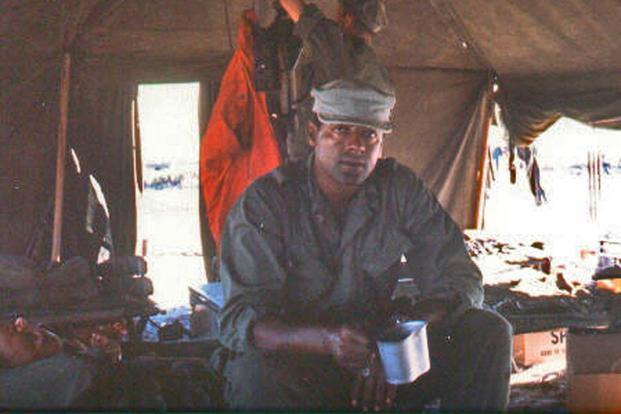With backing from Defense Secretary Jim Mattis, paperwork to upgrade the Navy Cross awarded to then-Marine Gunnery Sgt. John Canley to the Medal of Honor for his actions in the Battle of Hue City in 1968 was forwarded to President Donald Trump on Friday.
"After giving careful consideration to the nomination, I agree that then-Gunnery Sergeant Canley's actions merit the award of the Medal of Honor," Mattis said last month in a letter to Rep. Julia Brownley, D-California, Canley's chief sponsor in Congress.
Mattis noted that Congress would first have to waive the five-year limit for recommending the Medal of Honor, but once that happened, "I will provide my endorsement to the president."
In a statement Friday, Brownley said the House waived the time limit on Dec. 21 and the Senate took similar action Thursday.
All that is needed now is Trump's signature to give the nation's highest award for valor to the 80-year-old Canley, of Oxnard, California, who retired as a sergeant major and is reportedly battling cancer, Brownley said.
Related content:
- Ample Support for Gunny Canley’s MoH in Mark Bowden Book on Hue Battle
- Profiles in Courage: 5 Medal of Honor Recipients
- Video: WWI Medals Of Honor
In the brutal battle to retake Hue City in 1968, Canley's "valorous actions and unwavering dedication to his fellow service members is the reason so many of the men who support his nomination are alive today to testify on his behalf. His incredible gallantry and selflessness is an inspiration to us all," Brownley said.
In his account published last year -- "Hue 1968: A Turning Point of the American War in Vietnam," Mark Bowden, author of "Black Hawk Down" about the Battle of Mogadishu, cited Canley's actions in the house-to-house fighting more than 30 times.
In a statement to Brownley on the MoH recommendation, Canley said, "I want to profusely thank Congresswoman Brownley for her continued work helping me with this honor."
"The credit for this award really should go to all the young Marines in Vietnam who inspired me every day. Most of them didn't receive any recognition, but they were the foundation of every battle in the Vietnam War," he said.
John Ligato, who served as a private first class under Canley in Alpha Company, 1st Battalion, 1st Marine Regiment, 1st Marine Division, in Hue, said the Medal of Honor was long overdue.
Canley served several tours in Vietnam from 1965 to 1970. "The sheer cumulative effect of Gunny Canley's actions and deeds over this continued period rank with the acts of America's greatest heroes from the Revolutionary War to this present day," Ligato said. "This man is the epitome of a Marine warrior."
Others agreed. "I spent nine months in the St. Albans hospital, required numerous surgeries and am disabled, but I would have died if [Canley] had not risked his life for mine," said Pat Fraleigh, another Marine who served under him.
The battle of Hue "was not the first time I saw Gunny Canley act heroically," Fraleigh said.
In previous fighting at the Con Thien Marine base near the demilitarized zone, Canley "not only carried Marines to safety, but also exposed himself to enemy fire. He was always leading and attacking the enemy and always standing up and encouraging us," he said.
Canley's Navy Cross cites his actions from Jan.31 to Feb. 6, 1968, during which he took command of Alpha Company when the company commander was wounded.
"On 31 January, when his company came under a heavy volume of enemy fire near the city of Hue, Gunnery Sergeant Canley rushed across the fire-swept terrain and carried several wounded Marines to safety," the citation states.
Canley then "assumed command and immediately reorganized his scattered Marines, moving from one group to another to advise and encourage his men. Although sustaining shrapnel wounds during this period, he nonetheless established a base of fire which subsequently allowed the company to break through the enemy strongpoint."
On Feb. 4, "despite fierce enemy resistance," Canley managed to get into the top floor of a building held by the enemy. He then "dropped a large satchel charge into the position, personally accounting for numerous enemy killed, and forcing the others to vacate the building," the citation states.
The battle raged on. Canley went into action again on Feb. 6 as the company took more casualties in an assault on another enemy-held building.
"Gunnery Sergeant Canley lent words of encouragement to his men and exhorted them to greater efforts as they drove the enemy from its fortified emplacement," the citation reads. "Although wounded once again during this action, on two occasions he leaped a wall in full view of the enemy, picked up casualties, and carried them to covered positions.
"By his dynamic leadership, courage, and selfless dedication, Gunnery Sergeant Canley contributed greatly to the accomplishment of his company's mission and upheld the highest traditions of the Marine Corps and of the United States Naval Service," the citation states.
-- Richard Sisk can be reached at Richard.Sisk@Military.com.















